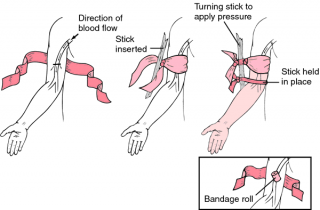TEOTWAWKI (The End of The World as We Knew It) has arrived! Regardless of where on Earth you happen to live, you’ve been notified that within the next 24 hours you must abandon your current shelter and strike out for the survival safe haven! What do you do? While this might seem like a highly unlikely scenario, it can and does occur, almost daily in some corner of the planet.
Each and every day on Earth poses the threat of disaster. With or without notice, a natural disaster can strike a location and completely alter the way of life for all those unfortunate enough to be caught up in the catastrophe. The same can be said for man-made disasters. In the troubled times we currently find ourselves in, terrorist attacks, mass shootings, politically fueled riots, protests, and even the threat of civil war, are all very real possibilities. Some of these situations have become so admired by the mainstream media that they are now becoming commonplace; a thread in the fabric of American society. All of these scenarios, as well as several others, are prime examples relevant to developing a bugout plan of action. In many of these situations, it will be necessary to abandon current living conditions, temporarily or permanently, and adapt to life as it was once lived by those who came before us.
There are plenty of in depth articles, packed with educational information, which deal with the topic of bugging out. These articles explain every aspect of leaving home and living off the land. They detail each and every item to have in a bugout bag, as well as the necessity for developing primary plans, secondary plans, and back-up plans for back-up plans. These informative pieces describe how to build shelters, establish fire, hunt, fish, and forage for food, find and purify water, and establish medical protocols for field first aid and medicine, as well as communications and signaling for rescue.
While all of that information is beneficial to those who read it, it is even more beneficial for those who actually practice it in real world environments. You cannot call yourself a “prepper,” or “survivalist,” unless you’ve actually endured a less than optimum environment. Camping alone does not cover all of the implements a survival situation will. One of the quickest ways to understand the need for survival gear, skill sets, and mental preparation, is to spend a night in the woods with nothing but the clothes on your back.
The Bag:
Since we are dealing with the absolute basics, the size of the bag should be no bigger than a normal backpack. It needs to hold the absolute basics for bugging out and little else. It should fit comfortably, have adjustable shoulder straps, and a weight reduction waist belt. Aside from that it should be waterproof, and be manufactured out of a sturdy fabric, preferably something similar to rip stop nylon fabric. It does not need to be huge, nor does it need to be packed to the breaking point.

Shelter:
Regardless of weather conditions, the first thing you will realize is the importance of shelter. You might become hungry or thirsty after a few hours away from home. However, an hour after the sun goes down you will forget all about food and water, as you begin searching for suitable shelter. It is for this reason that shelter tops the list of basic implements needed for bugging out. My personal preference for basic survival shelters are space blankets. Space blankets come in a variety of sizes. They can be used individually as a blanket to keep the body warm, arranged as a lean-to like half tent, or fashioned into a traditional two-man pup tent type structure. They are light weight and take up minimal space in the bugout bag.

Fire:
After shelter comes the need for fire. Without fire body heat will be difficult to maintain. Although you will have space blankets available, you will not want to remain wrapped in them 24 hours a day. Without fire the ability to purify water is greatly reduced. Without fire the ability to cook food and enjoy a hot meal, are non-existent. Without fire the ability to establish signals for rescue are drastically reduced. Without fire the ability to keep predatory animals at bay is also drastically reduced. Fire, if used properly, is a friend to humanity and therefore your survival.

Water:
When it comes to water it may be easier to manufacture water out of thin air, than it is to find a suitable source for human consumption. Water filters and purification equipment can be bulky and cumbersome. My personal preference includes bringing along an inline water filter, the Sawyer Mini is what I recommend, and having the ability to manufacture water through the construction of a solar still. This provides you with equipment in the event you find a favorable water source, as well as the ability to create water with nothing more than a sheet of plastic and the knowledge to build the still.

Food:
While an important aspect of survival, food is something the human body actually needs very little of in order to continue functioning. History has shown, through the horrors of the holocaust, what the human body is capable of when deprived of sufficient food. Personally, I view carrying food with you when bugging out as an unnecessary and cumbersome endeavor. Food takes up space, adds excessive weight to the bag, and creates a false sense of security. I recommend learning to forage for food first and foremost. Wild edibles will be in abundance and the easiest items to find. They add no weight to the bag and can be harvested straight from the field. Hunting and fishing should be used to supplement foraging excursions.

Medical:
As a bare minimum a small, compact, personal first aid kit should be included in the bag. This equipment should be sufficient to handle minor, non-life threatening wounds and injuries. The majority of people involved with prepping have minimal medical skills. Therefore, outfitting the bugout bag with triage type medical supplies is an unnecessary exercise that will provide no advantage. To address minor injuries, you need a disinfectant, something for pain relief, and the ability to stop bleeding. In most cases addressing more than a minor injury requires professional medical knowledge.

Personal Protection:
Personal protection should include a firearm. My personal preference is the AR-15 weapons platform. The lower receiver of an AR-15 is compatible with a number of upper receivers in various calibers. The two pin tear down system inherent to the AR platform allows the individual the opportunity to utilize a variety of upper receivers for various aspects of survival. With a .223/5.56mm upper the individual has a tactical rifle capable of providing protection in close quarters combat environments, and with a .308/7.62mm upper the individual has a rifle more conducive to hunting at long ranges. Handguns and shotguns are often mentioned for survival, but they are close range combat weapons which might be more suitable for home security or bugging in.

Additional Gear:
Cutting tools will come in handy for a number of obvious reasons. Have a hatchet, machete, fixed blade knife, and a small folding knife, in your gear at all times. Cordage is an absolute necessity. Several aspects of survival are easier to achieve when cordage is available. Communications equipment might come in handy, but functionality and range are not guaranteed; carry something light and rechargeable with kinetic energy, such as hand crank equipment. Navigation equipment may come in handy, provided you know how to use it.
Summary:
These are the bare essentials required to enhance the chances of successfully surviving. As mentioned previously. If you really want to begin to understand the need for gear, and in what priority, take a trip outside just before night falls. Carry a small notepad, pen, and penlight with you. As time passes make notes of the items you need the most. This will enlighten you as to the importance of each item as it pertains to your survival. If you opt to conduct this experiment, do so in the comfort of your backyard. This will eliminate the possibility of converting a simple survival exercise into a full blown search and rescue operation. Once you have put together your list of contents, and assembled your gear, put it to the test. Don’t plan a camping trip. Pack your gear and one day when you are struggling to find something to do, grab your bag and walk out the front door.
See how long you are able to survive without returning to the creature comforts of home. This will shed further light on what you might want to add, subtract, or modify. You must remember that having gear will make life easier, but being able to compensate for a lack of gear will make you better prepared for all scenarios in the long run.
Original article by Paleo Pete, published in Survivalist Magazine #28
Read All Articles From This Issue and More on STEEMIT Here
If you would like to see more survival and preparedness training, please UpVote & Share.

